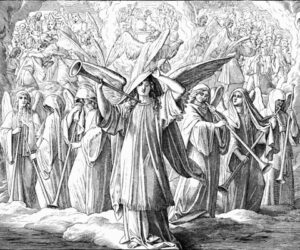
I was curious as to how the collaboration between Parker and Shaw began and ran across this nugget:
Parker received her master’s degree from the Juilliard School where she studied choral conducting with Robert Shaw. As Shaw began to organize the Robert Shaw Chorale, he enlisted the young Parker to do research and create choral arrangements for the new touring and recording ensemble. The many Parker/Shaw settings of American folk songs, hymns and spirituals from that period form an enduring repertoire for choruses all around the world. (from MorningStar Music Publishers) She spent 20 years as the chief arranger for Shaw’s choir.
Robert Shaw is sadly no longer around to frighten the living daylights out of his chorale members, but Alice Parker sure is. (Although her conducting style is by all accounts very accessible and friendly, unlike his.)
I guess I’d better get on to the actual subject of this post, the spiritual “John Saw Duh Numbuh.” I’d encourage you to read the post I wrote about how the spirituals came to be. It’s pretty interesting, if I do say so myself. These songs have layers of meaning and often a great depth of spiritual truth, produced by illiterate slaves who took what they gleaned from their oppressors’ teaching and wove them into great music.
Anyway, for this selection, we have four questions to answer.
First, who is this “John” who saw “the numbuh”? He is John the Apostle, not to be confused with John the Baptist, and wrote the Gospel of John, 1, II and III John, and the Book of Revelation in the Christian New Testament. (John the Baptist didn’t write any New Testament books but he’s in the Gospel of John, just to complicate matters.) Our selection is straight out of the Book of Revelation. According to Church history, John had been exiled to the Isle of Patmos for his Christian witness by the Roman government under Emperor Domitian. He says at the beginning of the book:
I, John, your brother and companion in the suffering and kingdom and patient endurance that are ours in Jesus, was on the island of Patmos because of the word of God and the testimony of Jesus (1:9 NIV).
He then goes on to detail the series of visions that he has about the coming judgment and end of the world. (By the way, the word “Apocalypse” is sometimes used as the title of Revelation; it is a transliteration of a Greek word that means “uncovering” or “revelation.” When you hear of an event being called “apocalyptic,” the reference is usually to a disastrous natural event that can seem like a divine judgment.)
Second, what is the “numbuh dat no man could numbuh”? The image comes straight from Revelation chapter 7, which takes place in Heaven and describes the innumerable crowd of believers before God’s throne:
After this I beheld, and, lo, a great multitude [or number], which no man could number, of all nations, and kindreds, and people, and tongues, stood before the throne, and before the Lamb, clothed with white robes, and palms in their hands (7:9 KJV).
Third, what is the “hundred forty thousan’”? This phrase comes from a few verses earlier in the same chapter as above:
And I heard the number of them which were sealed: and there were sealed an hundred and forty and four thousand of all the tribes of the children of Israel (7:4 KJV).
I’m not going to get into the deep theological discussions that try to determine how literally this statement is supposed to be taken. It’s interesting that the passage goes on to name each tribe of the nation of Israel from the Old Testament/Jewish Bible, with the number 12,000 being listed for each one. That seems very specific. Just after the listing of the tribes, though, comes the verse describing the multitude from all people of the world. I will quote a great old source here that gives at least one interpretation:
The number of those who were sealed, may be understood to stand for the remnant of people which God reserved. Though the church of God is but a little flock, in comparison with the wicked world, yet it is a society really large, and to be still more enlarged. Here the universal church is figured under the type of Israel (Matthew Henry’s Commentary).
But the overall message of the spiritual doesn’t concern itself with the finer issues. That point leads to our fourth question: What does the speaker in the song want? Answer: that he be included in the number of worshipers before the throne: “Tell John not to call duh roll till I git dere, comin’ up, comin’ on high.” In other words, he says, “Don’t let the number be closed until I come up there to join them.”
Here’s a great performance of this spiritual by the Missouri State University Chorale on their 2016 tour in South Africa, singing in a lovely location. My only quibble with it is that they’re saying “number” more than they’re saying “numbuh.” Oh well. The director is so totally involved with the performance that he’s part of the fun:
The actual lyrics are very short:
John saw duh numbuh dat no man could numbuh, Comin’up on high.
John saw duh hundred an’ forty four thousan’. Comin’ up on high.
Tell John not to call duh roll till I git dere. Comin’ up on high.
Are you reminded of another more famous spiritual here?
Oh when the saints go marchin’ in,
Oh when the saints go marchin’ in,
Oh Lord I want to be in that number
When the saints go marchin’ in.
Those words have exactly the same message as the ones in our selection: I want to be included in the blessed number of Heaven. I want to be there.
A great desire! And here’s a great, fun performance:
© Debi Simons

